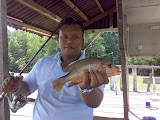PLAYING THE FISH

When a fish feels the hook, it struggles to get free. This might involve jumping, making a long run, swimming back against the line or swimming around obstacles. Each species of fish fights differently.
Fish hooked in shallow water are more likely to jump and behave more frantically than those hooked in deep water. Deep-water fish often seek the bottom.
It's possible to land many small fish just by reeling them in. They'll fight, but they aren't as strong as the line and the rod. Use lighter tackle and you can get some fight out of the smallest fish in the lake.
If you're catch and release fishing, don't fight too long or the fish will die from exhaustion before or after you release it.
Fighting Bigger Fish
Setting the Drag
If a fish makes a run for it, don't panic. And don't try to reel in while the fish is swimming away from your line. Relax and let the drag and rod do the work. After you've set the hook, set your drag. If you're using 12-pound test, you should use about 4 pounds of drag. Just keep the rod at about a 45-degree angle to the water aim it straight at the fish.
When the fish slows down and stops taking more line, it's time to go to work. The best technique for the catch is to gently pull the rod up and then reel down as you lower it, using a pumping motion. Do it in small, smooth strokes rather than large abrupt sweeps because it will help keep both the line tight and the fish much calmer.
If the fish runs again, let it go and you will probably notice that this run is shorter and slower. But don't let the fish rest. If you can't hear your drag working, you should be reeling.
Don't be anxious. Even if you get the fish close to the boat, that doesn't mean it's done fighting. If it turns and runs, let it go. Your line is pretty short at this point, and pump-and-reel action could break it.










0 comments:
Post a Comment